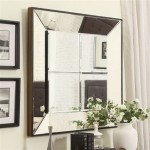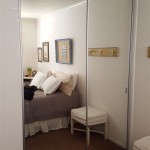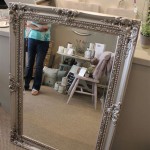How Big Should a Mirror Be Over a Couch?
Selecting the appropriate size mirror to hang above a couch is a crucial element of interior design, impacting both the aesthetic appeal and the overall perception of the space. A well-chosen mirror can enhance natural light, create the illusion of greater room size, and serve as a focal point, tying together the various elements of the living room. Conversely, a poorly sized mirror can appear disproportionate, detract from the room's harmony, and even diminish its visual impact. Therefore, careful consideration must be given to several factors when determining the ideal dimensions for a mirror intended to grace the wall above a couch.
The process of selecting the perfect size mirror is not governed by a single, rigid rule. Instead, it involves a nuanced understanding of proportions, spatial relationships, and design principles. The size of the couch itself, the height of the ceiling, the available wall space, and the desired aesthetic effect all play significant roles in the decision-making process. Understanding these factors is paramount to achieving a balanced and visually pleasing outcome.
One of the most common mistakes in interior design is choosing a mirror that is either too small or too large for the space. A small mirror can get lost above a large couch, appearing insignificant and failing to make a meaningful impact. On the other hand, an excessively large mirror can overwhelm the space, dominate the room, and potentially create an unsettling or unbalanced feeling. Striking the right balance is key to achieving a cohesive and visually appealing design.
This article will explore the key considerations involved in determining the appropriate size mirror for the wall space above a couch. By examining the relevant factors and providing practical guidelines, it aims to equip readers with the knowledge necessary to make informed decisions and enhance the aesthetic appeal of their living spaces. The following sections will delve into proportions, wall space considerations, and common design principles.
Proportion and the Two-Thirds Rule
One of the most widely cited rules of thumb in interior design is the "two-thirds rule." This principle suggests that the width of the mirror should generally be about two-thirds of the width of the couch. This guideline provides a starting point for determining the appropriate dimensions, ensuring that the mirror is substantial enough to make a visual statement without overwhelming the seating area. However, it is important to recognize that this rule is not absolute and should be adapted based on the specific characteristics of the room and the desired effect.
To apply the two-thirds rule, first measure the width of the couch. Then, multiply that measurement by two-thirds (or approximately 0.67). The resulting number provides an estimate for the ideal width of the mirror. For example, if a couch is 90 inches wide, the recommended mirror width would be approximately 60 inches. This measurement serves as a foundational guideline, but further adjustments may be necessary based on other factors.
While the two-thirds rule primarily addresses the width of the mirror, the height is also an important consideration. Generally, the height of the mirror should be proportionate to its width, creating a balanced and harmonious appearance. A common approach is to aim for a mirror that is roughly square or slightly rectangular, avoiding excessively tall or short dimensions. The height of the ceiling and the overall scale of the room can also influence the optimal height of the mirror.
It is important to consider the style of the mirror itself when applying the two-thirds rule. A mirror with a thick, ornate frame will occupy more visual space than a frameless or minimally framed mirror. In cases where the mirror has a substantial frame, it may be necessary to slightly reduce the dimensions to prevent the mirror from appearing too dominant. Conversely, a frameless mirror may benefit from a slightly larger size to compensate for its less visually prominent presence.
The two-thirds rule is a valuable tool for achieving visual balance, but it is not a rigid constraint. It serves as a starting point for the design process, allowing for adjustments based on individual preferences and the specific characteristics of the space. Ultimately, the goal is to select a mirror that complements the couch and enhances the overall aesthetic appeal of the room, creating a cohesive and harmonious design.
Assessing Available Wall Space
Beyond the proportions relative to the couch, the available wall space is a crucial factor in determining the appropriate size mirror. Taking precise measurements of the wall area above the couch will inform decisions about the maximum dimensions that can be accommodated without creating a cluttered or cramped appearance. Failing to consider available wall space can result in a mirror that feels either too imposing or too insignificant within the room's context.
First, measure the width of the wall space above the couch. This measurement will establish the maximum width that the mirror can occupy without extending beyond the boundaries of the available space. It is generally advisable to leave some breathing room on either side of the mirror, preventing it from feeling crowded or visually overwhelming. A good rule of thumb is to leave at least a few inches of wall space on either side of the mirror, ensuring that it is properly framed by the surrounding area.
Next, assess the height of the wall and the distance between the top of the couch and the ceiling. This measurement will determine the maximum height of the mirror. It is essential to consider the height of the ceiling, as a mirror that extends too close to the ceiling can create a sense of imbalance or visual discomfort. Conversely, a mirror that is positioned too low on the wall may appear disconnected from the couch and the overall composition of the room.
Consider the presence of any architectural features, such as windows, doorways, or moldings, that may impact the placement and size of the mirror. These features can either serve as constraints or opportunities to integrate the mirror into the existing design. For example, a mirror can be positioned to reflect natural light from a nearby window, enhancing the brightness and spaciousness of the room. Alternatively, the mirror can be aligned with existing architectural elements to create a sense of visual harmony and order.
It is also important to account for any other decorative elements that may be present on the wall, such as artwork, sconces, or shelves. The mirror should be positioned and sized in such a way that it complements these elements without overshadowing them or creating a cluttered appearance. The goal is to create a cohesive and balanced composition that integrates all of the decorative elements into a unified design.
Ultimately, the assessment of available wall space is a critical step in determining the appropriate size mirror. By carefully measuring the wall area, considering architectural features, and accounting for other decorative elements, it is possible to select a mirror that fits seamlessly into the room's context and enhances its overall aesthetic appeal. A well-proportioned mirror can transform the appearance of a living room, creating a more spacious, inviting, and visually pleasing environment.
Design Principles and Aesthetic Considerations
Beyond the proportional guidelines and wall space considerations, design principles and aesthetic preferences play a significant role in determining the ideal size mirror for placement above a couch. The desired style, the existing decor, and the overall ambiance that is being sought all influence the selection process. The mirror should not only fit the space physically, but also complement the existing design elements and contribute to the overall aesthetic vision.
Consider the style of the room and the existing furniture. Is the room designed in a modern, traditional, minimalist, or eclectic style? The mirror should complement the overall style of the room, both in terms of its size and its design. For example, a large, ornate mirror may be appropriate for a traditional or opulent living room, while a smaller, simpler mirror may be more suitable for a modern or minimalist space.
Reflect upon the primary purpose of the mirror. Is it primarily intended to enhance natural light, create the illusion of greater space, or serve as a decorative focal point? The intended function of the mirror can influence the optimal size and placement. A mirror designed to maximize light reflection may benefit from a larger size and strategic positioning relative to windows or other light sources. A mirror intended to serve as a focal point may require a bolder design and a more prominent placement on the wall.
Experiment with different shapes and orientations. While rectangular mirrors are the most common choice for placement above a couch, other shapes, such as round, oval, or asymmetrical designs, can create a unique and eye-catching effect. Consider the impact of different shapes on the overall balance and harmony of the room. A round mirror can soften the lines of a rectangular couch, while an asymmetrical mirror can add a touch of visual interest and personality.
Evaluate the existing color palette and textures within the room. The mirror should complement the existing color scheme and textural elements. A mirror with a frame that matches the color or finish of other furniture pieces can create a sense of visual cohesion. Conversely, a mirror with a contrasting frame can add a pop of color or visual interest to the room. The texture of the frame, whether smooth, textured, or metallic, should also harmonize with the existing textures in the room.
Ultimately, the selection of the appropriate size mirror is a subjective process that is guided by design principles and aesthetic considerations. By carefully evaluating the style of the room, the intended function of the mirror, and the existing color palette and textures, it is possible to choose a mirror that not only complements the couch but also enhances the overall beauty and appeal of the living space. A well-chosen mirror can transform the ambiance of a room, creating a more inviting, stylish, and visually pleasing environment.

Tips On Hanging A Mirror Over Furniture C Home Limited
:strip_icc()/cdn.cliqueinc.com__cache__posts__189779__large-round-mirrors-189779-1528326128816-main.700x0c-6e62240fb50344ed8626b2537ad786fa.jpg?strip=all)
30 Ways To Style Large Round Mirrors

Tips On How High To Hang A Mirror Interior Design Blog Hadley Court

Tips On How High To Hang A Mirror Interior Design Blog Hadley Court
:strip_icc()/cdn.cliqueinc.com__cache__posts__189779__this-neat-trick-makes-your-room-look-bigger-and-chic-1731602-1460589762.700x0c-16b124fc700a4406a2da75d5f6b6766c.jpg?strip=all)
30 Ways To Style Large Round Mirrors

Tips On How High To Hang A Mirror Interior Design Blog Hadley Court

Mirror Over The Mantel What Size To Get Laurel Home

Kylie M Interiors The Right Height To Hang Artwork
:strip_icc()/Designer_KatieHackworthPhotographer_BelatheePhotography1-5ec16af89e9242cabd3c637c7eb23d4b.jpg?strip=all)
10 Feng Shui Rules For Mirrors According To Experts

Feng Shui Mirrors In Living Room Tips To Placing Them Right Benefits








